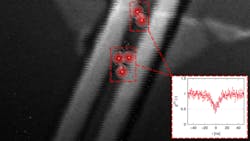2D-based single-photon emitters are integrated with CMOS-compatible silicon nitride waveguides
Researchers from the Photonics Research Group (an Imec research group at Ghent University in Leuven, Belgium) and the Massachusetts Institute of Technology (MIT; Cambridge, MA) say they have integrated single-photon emitters (SPEs) in 2D layered materials with a silicon nitride (SiN) photonic chip.1 With this approach, even for moderate quantum yields, dielectric cavities could be designed such that the single-photon extraction into the guided mode could reach unity, providing a crucial step forward in fundamental quantum photonics and 2D materials research.
Photonic integrated circuits (PICs) enable the miniaturization of complex quantum optical circuits connecting large numbers of photonic devices with optimized insertion losses and phase stability. The SPE is a central building block for such an integrated quantum circuit, and a variety of materials systems have been investigated to create such on-chip SPEs. 2D-based SPEs have some unique properties that make them particularly appealing for integration with PICs. First, they can be easily interfaced with PICs and stacked together to create complex heterostructures. Second, due to their thinness, and the absence of total internal reflection, they enable very high light-extraction efficiencies without the need of any additional processing, allowing efficient single-photon transfer between the host and the underlying PIC. Third, 2D materials grown with high wafer-scale uniformity are becoming more readily available.
Through nanoscale strain engineering, the team coupled 2D-based SPEs with a CMOS-compatible SiN waveguide and extracted crucial performance parameters for this source, using them in an optimization analysis to maximize single-photon extraction and indistinguishability into the guided mode.
“These results provide a crucial step in scaling up quantum photonic devices using 2D-based integrated single-photon sources,” says Frédéric Peyskens, one of the researchers.
Source: Imec
REFERENCE:
1. Frédéric Peyskens et al., Nature Communications (2019); https://doi.org/10.1038/s41467-019-12421
Got optics- and photonics-related news to share with us? Contact John Wallace, Senior Editor, Laser Focus World
Get more like this delivered right to your inbox
About the Author
John Wallace
Senior Technical Editor (1998-2022)
John Wallace was with Laser Focus World for nearly 25 years, retiring in late June 2022. He obtained a bachelor's degree in mechanical engineering and physics at Rutgers University and a master's in optical engineering at the University of Rochester. Before becoming an editor, John worked as an engineer at RCA, Exxon, Eastman Kodak, and GCA Corporation.

